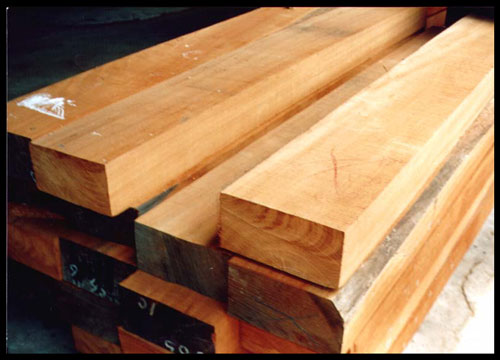Kapur

INTRODUCTION
The Standard Malaysian Name for the timber of Dryobalanops spp. (Dipterocarpaceae). Vernacular names applied to this timber include kapur(Peninsular Malaysia, Sabah and Sarawak) with various epithets, keladan (Peninsular Malaysia) and kelansau (Sarawak). Major species include D. aromatica, D. beccarii,D. keithii, D. lanceolata, D. oblongifolia and D. rappa. The sapwood is yellowish brown and sharply defined from the heartwood, which is reddish brown.
DENSITY
The timber is a Medium Hardwood with a density of 580-820 kg/m3 air dry.
NATURAL DURABILITY
Standard graveyard test of untreated D. aromatica and D. oblongifolia specimens of dimension 51 mm x 51 mm x 610 mm had been conducted in the Forest Research Institute Malaysia (Jackson, 1965). From the studies conducted, the average service life of D. oblongifolia and D. aromatica were 1.9 and 6.0 years respectively. It can be seen that there is a remarkable difference in the natural durability of these two species and based on the weakest species, kapur is therefore classified as not durable. It is known that these two species are resistant to fungal attack, but are susceptible to termite attack.
PRESERVATIVE TREATMENT
The timber is not amenable to preservative treatment and it is classified as difficult to treat.
TEXTURE
Texture is moderately coarse and even with straight or shallowly interlocked or sometimes deeply interlocked grain.
STRENGTH PROPERTIES
The timber falls into Strength Group B (Engku, 1988b) or SG 4 (MS 544:Part 2:2001).
Strength Properties of Kapur
Species | Test condition | Modulus of Elasticity (MPa) | Modulus of Rupture (MPa) | Compression parallel to grain (MPa) | Compression perpendicular to grain (MPa) | Shear strength (MPa) |
D. aromatica | Green | 15,900 | 84 | 46.5 | 4.2 | 8.4 |
Air dry | 18,700 | 114 | 61.7 | 5.5 | 10.5 | |
D. oblongifolia | Green | 13,200 | 73 | 39.2 | 5.1 | 8.1 |
Air dry | - | - | - | - | - |
MACHINING PROPERTIES
The timber of D. rappa is easy to work while the other species range from moderately easy to slightly difficult.
Sawing and Woodworking Properties of Kapur
Species Tested | Test Condition | Sawing | Planning | Boring | Turning | ||||
Re-sawing | Cross-Cutting | Ease of planing | Quality of finish | Ease of boring | Quality of finish | Ease of turning | Quality of finish | ||
D. aromatica | Green | moderately easy | easy | easy | moderately smooth | easy | smooth | - | - |
Air dry | easy | easy | easy | moderately smooth | easy | smooth | easy | moderately smooth | |
D. oblongifolia | Green | easy to slightly difficult | easy | easy | rough | easy | smooth | - | - |
Air dry | slightly difficult | easy | easy | smooth | easy | smooth | easy | moderately smooth | |
NAILING PROPERTY
Nailing property is good in D. rappa and poor in the other species.
AIR DRYING
The timber dries moderately slowly to slowly with little degrade. The seasoning properties of some species are summarised below:
Species | Time to air dry (months) | Remarks | |
13 mm thick boards | 38 mm thick boards | ||
D. aromatica | 2 | 5 | Fairly slow drying; moderate end-splitting; splitting and surface-checking. |
D. rappa | 4 | 6 | Slow drying; moderate cupping due to very high differential shrinkage. |
KILN-DRYING
Kiln Schedule E is recommended. Care must be taken to stack the timber properly as there is a strong tendency to cup. 25 mm thick boards are expected to kiln-dry in 14 days.
Kiln Schedule E
Moisture Content (%) | Temperature (Dry Bulb) | Temperature (Wet Bulb) | Relative Humidity (%) (approx.) | ||
F | C | F | C | ||
Green | 120 | 48.5 | 115 | 46.0 | 85 |
60 | 120 | 48.5 | 113 | 45.0 | 80 |
40 | 125 | 51.5 | 116 | 46.5 | 75 |
30 | 130 | 54.5 | 117 | 47.0 | 65 |
25 | 140 | 60.0 | 120 | 49.0 | 55 |
20 | 155 | 68.0 | 127 | 53.0 | 45 |
15 | 170 | 76.5 | 136 | 58.0 | 40 |
SHRINKAGE
The shrinkage of some species are summarised below:
Species | Shrinkage (%) (Green to air dry) | Remarks | |
Radial | Tangential | ||
D. aromatica | 2.1 | 4.6 | Very high shrinkage. |
D. oblongifolia | 1.7 | 3.8 | High shrinkage. |
D. rappa | 1.5 | 5.1 | Very high differential shrinkage. |
DEFECTS
The most common defect that is associated with the timber is the pin-holes. It was reported that the pin-holes are more frequently found in D. aromatica than in D. oblongifolia (Desch, 1941). The pin-holes are caused by one of the small ambrosia beetles. The attack usually begins in the living tree and the attack cannot continue in seasoned wood. Spongy heart may occur in logs but the presence is usually insignificant.
USES
The timber is suitable for medium construction, posts, beams, joists, rafters, door and window frames and sills, fender supports, telegraphic and power transmission posts and cross arms, flooring, staircase (treads, angle blocks, rough brackets, bullnose, riser, balustrade, carriage, stringers, round end and winder), vehicle bodies (frame-work, floor boards and planking), ship and boat building (keels, keelsons and framework), pallets (heavy and permanent types), tool handles (impact), cooling tower (structural members), plywood, laboratory benches, column (light duty) and railway sleepers. In domestic flooring and internal fittings where finished appearance is important, care should be taken in fixing because of a tendency to develop an unsightly black stain in contact with iron nails, screws or other fittings.
I really like your site. Will keep checking back here.
ReplyDeleteMerbau Decking